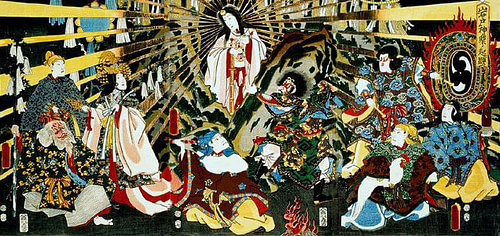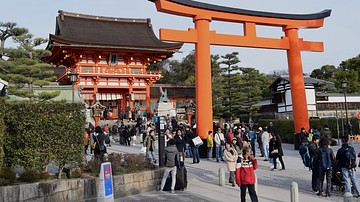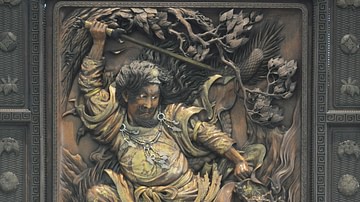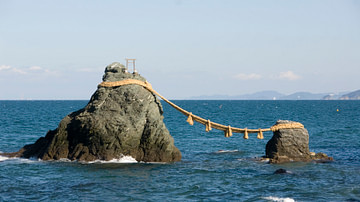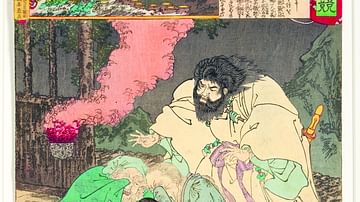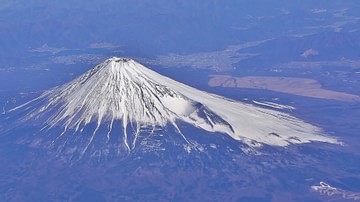
The Kojiki ('Record of Ancient Things') is the oldest book of Japanese history and the oldest text of any kind from Japan. Compiled in 712 CE by the court scholar Ono Yasumaro, the work begins with the gods and the creation of the world, progresses to the genealogy of the early emperors and ends with the reign of Empress Suiko in 628 CE. Not necessarily an accurate historical record, the Kojiki was principally commissioned to establish a clear line of descent from the ruling emperors of the 7th and 8th century CE back to the Shinto gods and the supreme sun goddess Amaterasu.
Purpose
During the Nara period (710-794 CE) of ancient Japan, the imperial court was eager to establish its historical connection with the gods, especially the sun goddess Amaterasu, and the founding fathers of the Japanese nation present in Shinto mythology. There was also a concern that oral traditions and unofficial records were constantly being altered and corrupted and an official permanent record was required for posterity. For these reasons, Emperor Temmu (r. 672-686 CE) commissioned the work, although he would not live to see its completion. The court official and scholar Ono Yasumaro was then selected by Empress Gemmei (r. 707-715 CE) to complete the collection and present, in effect, an established orthodoxy of Japanese history which focussed on Shinto mythology and the genealogy of the imperial line and most powerful noble families (uji), especially the Yamato clan. Yasumaro drew on earlier written and oral sources, mostly genealogies of powerful clans, and so the work is not only a valuable record of its time but also of earlier, now lost texts and traditions.
Content
The Kojiki was written in Chinese characters but with some Japanese adaptions in terms of sentence structure. There are some elements such as certain gods and names which show influence from China and Korea, but the work is, as a whole, an entirely Japanese construction. Not only a work of prose, the Kojiki, like many later Japanese works, regularly inserts into the text poems and folk songs. The work is divided into three books which deal with gods, early hero-like emperors, and then later emperors in turn, but there is no driving narrative or central character or theme. This absence of structure can increase the difficulty in reading the Kojiki, and there are, consequently, many inconsistencies, disappearing characters, and unanswered questions.
The Kojiki is most celebrated for its description of the 'Age of the Gods' when the world and Japanese islands were created and the gods ruled before withdrawing to leave humanity to rule itself. Indeed, there is said to be 8 million gods or spirits (kami) in the Kojiki, although, this is traditionally a number associated with 'infinite' so is not to be taken literally. There are creation gods, gods of fire, storms, sea and winds, as well as countless kami manifested in mountains, rivers, trees, and any other natural features of note. There are ancestor gods who head important families and locales and then there is a whole group of demons, evil spirits, and goblins, which inhabit forests, lakes, and graveyards, all awaiting the opportunity to commit mischief on the hapless passer-by.
The stories of the gods are often violent and bloody, with instances of parents killing children and siblings either doing away with each other or forming incestuous relations. The parts of the Kojiki relating the reigns of Japan's early emperors are rather more staid and considered by modern scholars to be historically unreliable. Only with the last 250 years of monarchs is it possible to cross reference some details with contemporary Chinese and Korean sources. Further, the age of the Japanese state, traditionally founded in 660 BCE, is thought exaggerated by its authors so that Japan could claim an equal footing with contemporary China and Korea.
Extracts from the Kojiki
Original preface by Ono Yasumaro:
So in the dimness of the great commencement, we, by relying on the original teaching, learn the time of the conception of the earth and of the birth of islands; in the remoteness of the original beginning, we, by trusting the former sages, perceive the era of the genesis of Deities and of the establishment of men. (Kojiki, 5)
Izanami and Izanagi create the first island of Japan:
Hereupon all the Heavenly Deities commanded the two Deities His Augustness the Male-Who-Invites [Izanagai] and Her Augustness the Female-Who-Invites [Izanami], ordering them to “make, consolidate and give birth to this drifting land.” Granting to them a heavenly jewelled spear, they deigned to charge them. So the two Deities, standing upon the Floating Bridge of Heaven, pushed down the jewelled spear and stirred with it, whereupon, when they had stirred the brine till it curdled, and drew the spear up, the brine that dripped down from the end of the spear was piled up and became the island. This is the Island of Onogoro. (Kojiki, 22)
Susanoo kills the dragon monster and finds the sword which will eventually become part of the Japanese regalia:
…the eight-forked serpent came truly as the old man had said, and immediately dipped a head into each vat, and drank the liquor. Thereupon it was intoxicated with drinking and all eight heads lay down and slept. Then His-Swift-Impetuous-Male-Augustness [Susanoo] drew the ten-grasp sabre, that was augustly girded on him, and cut the serpent in pieces, so that the River Hi flowed on changed into a river of blood. So when he cut the middle tail, the edge of his august sword broke. Then, thinking it strange, he thrust into the split flesh with the point of his august sword and looked, and there was a sharp great sword. (Kojiki, 75)
Poem from Princess Nunakawa to Okuninusho:
Come in the dark,
When the sun has disappeared
And the night emerges
Behind the green hills.
Come smiling, like the morning sun
In all its glory,
And take in your embrace
My arms white as
Ropes of Taku fiber,
My breasts, young and soft,
As the first fall of snow;
Clasp me in your arms.
Then you will sleep,
Your legs stretched out,
Your head pillowed on
My jewellike hands;
So do not press your love
Too importunately,
Great Divinity
Of eight thousand spears.
(Kojiki, quoted in Keene, 45)
The death of Jimmu (660-585 BCE), Japan's first emperor:
His Augustness Kamu-nuna-kaha-mimi [Emperor Suwizei] ruled the Empire. Altogether the august years of this Heavenly Sovereign Kamu-yamato-ihare-biko [Emperor Jimmu] were one hundred and thirty-seven. His august mausoleum is on the top of the Kashi Spur on the northern side of Mount Unebi. (Kojiki, 185)
The unusual physical features of Emperor Hanzei (r. 406-410 CE):
His Augustness Midzu-ha-wake dwelt in the palace of Shibakaki at Tajihi, and ruled the Empire. The length of this Heavenly Sovereign's august person was nine feet two inches and a half [2.8 metres]. The length of his august teeth was one inch [2.5 cm], and their breadth two lines, and the upper and lower correspond exactly, like jewels strung. (Kojiki, 353)
Legacy
The Kojiki shortly had a sequel of sorts in the Nihon Shoki ('Chronicle of Japan' and also known as the Nihongi), which was written by a committee of court scholars in 720 CE. It was designed to address some of the discrepancies in the earlier work and to reassert the genealogies of some of the clans neglected in the Kojiki. The Nihon Shoki also repeats many of the myths of the Kojiki but often from a different viewpoint and with changes in details.
The Kojiki is more than an invaluable history source and entertaining compilation of Japanese mythology, it is the cornerstone of the Shinto religion, its gods and rituals. The work was somewhat neglected in the medieval period but made a stunning comeback to public attention in the 18th century CE when the scholar Motoori Norinaga (1730-1801 CE) famously wrote a 44-volume commentary on the Kojiki in 1798 CE. Motoori's book, the Kojiki-den, would fuel a great revival in the Shinto and see it reinstated as the state religion. The Kojiki continued to be influential in the 19th and 20th century CE, too, with the rise of Japanese nationalism when it was used as evidence that the Japanese people were descended from the gods and so were superior to other races. The book continues to be studied today not only for its mythology but also its insight into early Japanese culture, the beliefs and stylistic approach of its authors, and the evolution of the Japanese language.
This content was made possible with generous support from the Great Britain Sasakawa Foundation.
